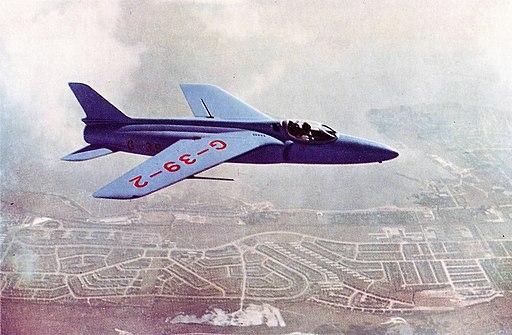
ASN Wikibase Occurrence # 232254
This information is added by users of ASN. Neither ASN nor the Flight Safety Foundation are responsible for the completeness or correctness of this information.
If you feel this information is incomplete or incorrect, you can submit corrected information.
| Date: | Tuesday 31 July 1956 |
| Time: | 16:15 LT |
| Type: |  Folland Gnat prototype |
| Owner/operator: | Folland Aircraft Ltd |
| Registration: | G-39-2 |
| MSN: | FL.2 |
| Fatalities: | Fatalities: 0 / Occupants: 1 |
| Aircraft damage: | Destroyed |
| Location: | Snoddington Manor Farm, Shipton Bellinger, Hampshire -
 United Kingdom United Kingdom
|
| Phase: | En route |
| Nature: | Test |
| Departure airport: | Chilbolton, Hampshire (EGIC) |
| Confidence Rating: |
The Folland Gnat prototype, serial number G-39-2, which first flew on 18 July 1955 from Boscombe Down Wiltshire. Written off (destroyed) 31 July 1956: the prototype G-39-2 crashed at Snoddington Manor Farm, Shipton Bellinger, near Stockbridge, Hampshire and was destroyed after structural failure caused by tailplane flutter which breaks away. The pilot ejected safely, becoming the first pilot ever to use the custom-designed Folland/SAAB ejector seat. (The Gnat prototype was not fitted Martin-Baker ejector seats as they would not fit in the cockpit).
Extract from the pilot's report on the incident:
"...I then thought of baling out for the first time and to reduce speed I extended the airbrake. This resulted in a nose-down trim change which use of the emergency trimmer failed to correct. Although my airspeed was close to 450 knots I decided to bale out because my indicated altitude was 1200 ft. I put the safety lever on to FIRE and jettisoned the canopy. I attempted to reach the blind with both hands but by this time the aeroplane was banking to port. My right arm was blown back and when I looked for the blind I saw it streaming behind the cockpit on the left hand side. I grasped it at the root, closed my eyes and pulled.
The ejection was perfectly smooth and by the time I had opened my eyes I saw the seat some 50 yards away. I pulled the rip cord, not daring to wait for the automatic as I appeared to be quite close to the ground. The parachute opened and I landed some 10 or 12 seconds later.
I barked both shins on the underside of the instrument panel during the violent pitching oscillations described above and I bruised my right forearm at some stage during the ejection. Apart from this I appear to have suffered no ill effects. I can only congratulate the Seat Section on their successful work during the last 18 months."
According to a contemporary newspaper report ("Western Mail" - Wednesday 1 August 1956):
"New jet aeroplane crashes
The prototype of the Folland Gnat, the first light jet aeroplane to be designed, crashed at Snoddington Manor Farm, between Tidworth and Amesbury, Wilts., while on a test flight yesterday.
Folland's chief test pilot, Squadron-leader E. A. Tennant, escaped unhurt by using the ejector seat. The aeroplane came down among trees and caught fire. It was undergoing high-speed flying tests at low altitudes from Chilbolton Aerodrome. where Folland's have their home flying development unit.
Squadron-leader Tennant, former fighter pilot, was appointed chief test pilot of Folland Aircraft, Ltd., in 1953. He qualified as an R.A.F. pilot in 1941 and by the end of the war had flown some 250 sorties and won the D.F.C."
The reported crash location of Shipton Bellinger is a village and civil parish in Hampshire, England on the Hampshire/ Wiltshire border. Shipton Bellinger is about 5 miles (8 km) north-east of the town of Amesbury and 12 miles (19 km) north-east of the city of Salisbury. It is on the A338 road, near its junction with the A303 road. It is in the Test Valley (Hampshire) council district but its postal address is Tidworth in Wiltshire. The village is surrounded by Salisbury Plain. It is close to Tidworth Camp and a number of British Army families live in the village.
Sources:
1. https://en.wikipedia.org/wiki/Folland_Gnat#Accidents_and_incidents
2. National Archives (PRO Kew) File BT233/349: https://discovery.nationalarchives.gov.uk/details/r/C424470
3. National Archives (PRO Kew) File AVIA 5/35/S2830: https://discovery.nationalarchives.gov.uk/details/r/C6578610
4. https://www.thunder-and-lightnings.co.uk/gnat/history.php
5. http://sussexhistoryforum.co.uk/index.php?topic=9084.5;wap2
6. http://www.ukserials.com/losses-1956.htm
7. http://www.hampshireairfields.co.uk/hancrash.html
8. https://www.baesystems.com/en-uk/heritageimage/folland-gnat-prototype-g-39-2-on-take-off-run-in-1955
9. https://en.wikipedia.org/wiki/Shipton_Bellinger
Media:
The Folland Gnat prototype, serial number G-39-2, which first flew on 18 July 1955.

Revision history:
| Date/time | Contributor | Updates |
|---|---|---|
| 20-Jan-2020 19:08 | Dr. John Smith | Added |
| 20-Jan-2020 19:11 | Dr. John Smith | Updated [Location, Narrative] |
Corrections or additions? ... Edit this accident description
The Aviation Safety Network is an exclusive service provided by:


 ©2024 Flight Safety Foundation
©2024 Flight Safety Foundation